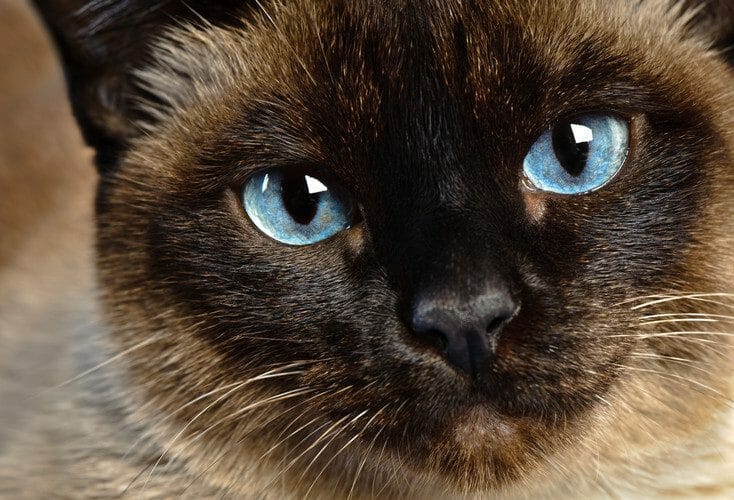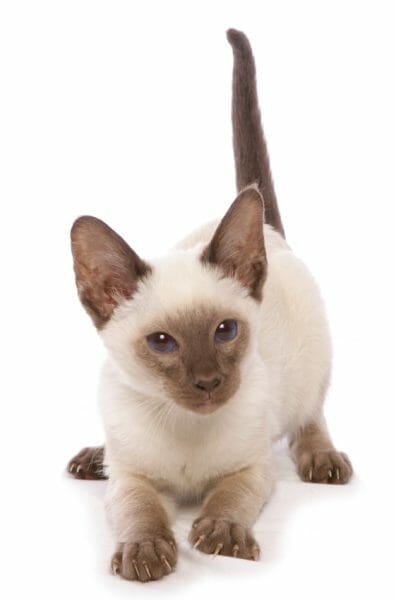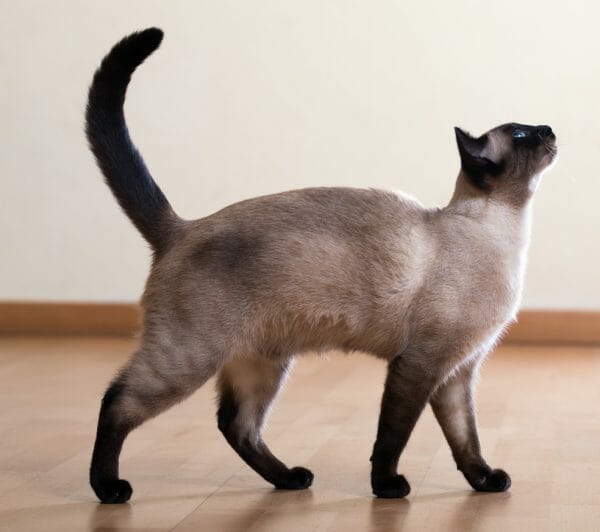Siamese Cat

Siamese Cat Personality
The beautiful and intelligent Siamese cat is affectionate and lavishes plenty of attention on its owner. However, these felines demand affection and attention in return. Like other intelligent felines, these cats know its own desires. Their intelligence is such that it can often be taught to walk on a lead.
These playful cats require lots of toys to keep them entertained. They can easily be taught how to play fetch. Because of its need for attention, these felines should not be left alone for too long. These felines will thrive in an environment where there are other pets to keep it company. These felines do not fare well outdoors, so it is advisable to keep them indoors.

Siamese Cat Appearance
Siamese cats have a long, lean, muscular body with thin tails and limbs. This, combined with the distinct colorpoint patterns, make the breed easy to recognize. With dark fur on the tail, legs, and around the face and ears, the Siamese has an air of mystery to it. One of the most distinguishing features of the breed is its striking blue eyes.
Although many of these felines have a cream-colored body and dark colors on its points (e.g., ears, paws, tail, and face), four combinations are officially recognized. Siamese cat colors include:
- Blue Point: Light silver body with a blue gray colorpoint
- Chocolate Point: Ivory body with a chocolate brown colorpoint
- Lilac Point. Light cream body with a gray pink colorpoint
- Seal Point. Fawn body with a seal colorpoint
A Flame Point Siamese (also called a Red Point Siamese) has a red colorpoint pattern. However, many cat registries do not officially recognize this rare coloring.
Many potential owners will ask “are Siamese cats hypoallergenic?” Although no cat is truly suitable for allergy sufferers, this breed does produce less of the Fel d 1 protein associated with allergies and its short hair limits the amount it sheds.

History of the Siamese Cat
Originating in Siam (now Thailand), descriptions and illustrations of the Siamese cat (or the Wichienmaat) first appeared in a series of ancient manuscripts known as the “Tamra Maew.” These manuscripts are believed to have originated in the Ayutthaya Kingdom between 1351 and 1767.
At the end of the Burmese-Siamese war in 1767, the city of Ayutthaya was sacked, and the Siamese nobility and royal family were taken captive. The King of Burma learned that Thai cats, including the Siamese, were highly revered and believed to bring wealth to their owners. This led the king to instruct his army to round up all the cats and deliver them to Burma.
The first of the breed to be exported to the United States was gifted to President Rutherford B. Hayes in 1878 by the American Consul in Bangkok. In 1884, a breeding pair was sent to Great Britain and shown at the Crystal Palace Show.
Siamese have been portrayed in popular culture, most notably in Disney movies such the “Lady and the Tramp” and “The Aristocats.” The breed is also featured in the children’s animated TV series “Sagwa, The Chinese Siamese Cat,” which is based on a children’s book of the same name by Amy Tan.

Siamese Cat Health Problems
Although generally healthy, there are several conditions known to affect the breed.
- Amyloidosis. This disease affects the liver and occurs when amyloid cells are deposited outside of the cat’s organs. This condition is usually seen in felines around the age of seven and can be fatal or reduce the sufferer’s lifespan dramatically.
- Asthma. Felines with asthma occasionally have difficulty breathing. This may be combined with increased respiratory rates, coughing, and wheezing. In some cases, it can cause the cat to vomit. These symptoms will vary in severity, and treatment usually involves the use of corticosteroids to reduce inflammation in the lungs.
- Cancer. There are several types of cancer that may affect the breed, particularly lymphoma. Fortunately, this is an easily detectable and treatable form of cancer. A veterinarian will often recommend chemotherapy as the best treatment option.
- Dental Disease. Examples of dental conditions that could affect these felines include tooth resorption, gingivitis, and periodontitis. Regular cleaning of the teeth is essential, and owners should ensure the cat’s gums are examined regularly by a veterinarian.
- Progressive Retinal Atrophy (PRA). PRA is caused by a mutation on the rdAc-gene and leads to retinal degeneration and ultimately, loss of vision. There is no treatment for this condition.
Through the efforts of many Siamese cat breeders, many genetic health problems are now rare.

How Long Do Siamese Cats Live?
The Siamese cat lifespan is quite long. This breed generally lives between 15 and 20 years, with some living even longer. To ensure a long and healthy life, it is important that the feline has regular assessments from a veterinarian to ensure there are no clinical signs of serious health concerns. In addition, core vaccines (such as those for rabies and distemper) should be administered. Heartworm medication should be provided monthly, along with flea and tick preventatives if appropriate.
Breeds Derived from the Siamese Cat
There are several popular feline breeds that are derived from the Siamese, including:
- Balinese. This breed comes from a naturally occurring mutation and are sometimes known as longhaired Siamese cat.
- Bengal. The popular Bengal derives from a cross between a Siamese and Asian Leopard cat.
- The modern Birman was bred from the Siamese in the early 20th century.
- Burmese. A single Burmese called Wong Mau was bred with a Siamese in San Francisco in the 1930s. Although technically not derived from the Siamese cat, the two breeds have been heavily crossbred.
- Himalayan. Himalayan cats are longhaired crosses between the Persian and Siamese breeds.
- Savannah. Although the Savannah comes from breeding Serval and domestic cats, the first Savannah was bred using a Siamese.
- Tonkinese. Tonkinese cats come from breeding Burmese and Siamese cats.

Finding a Siamese Cat for Sale
When looking for a Siamese cat for sale, it is important to remember that pets are frequently given up for adoption for a variety of reasons. Before searching for a Siamese cat breeders directory, it is important to check rescue shelters first. Some areas may even have specific Siamese cat rescue centers.
However, it is always important to ensure that an animal comes from a no-kill shelter. This type of rescue center will never euthanize a healthy animal and will always endeavor to ensure that any Siamese cats for adoption find a new home. If you’re interested in a feline related to the Siamese (such as a Bengal, Burmese or Himalayan), consider that a shelter may be the best option as the Bengal cat price can run as high as $1,500 to $3,000 per kitten.



